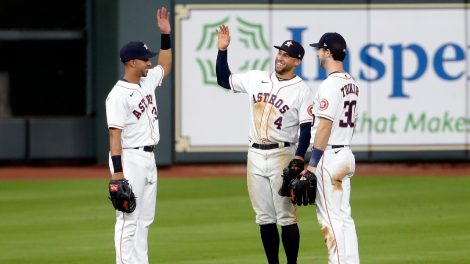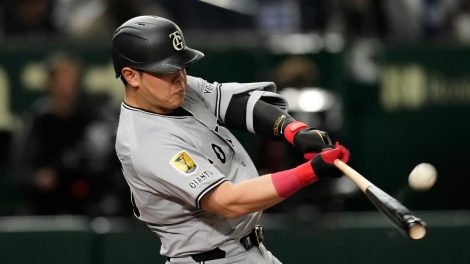DUNEDIN, Fla. – When the Toronto Blue Jays dismissed Eric Owens last October, conventional wisdom suggested they’d replace him with another assistant hitting coach. Instead, they changed not only the coach but the entire job description, hiring Derek Shelton in an all-encompassing role that will see him work with position players, pitchers, coaches and front office staff. The job title: quality control coach.
[sidebar]
If the role sounds unfamiliar, it’s because it hadn’t crossed over to baseball until recently. Shelton’s the American League’s lone quality control coach, joining four National Leaguers and a wider range of NFL coaches.
“Honestly for me, it was a lot less about the title and it was more about the fact that this is where I want to be,” Shelton said.
“There’s more to the title than the two words in it,” Blue Jays general manager Ross Atkins added. “He’ll be impacting not only hitting but collaborating with our defence and pitching and working with our analytics to help our players get better on an individual to individual level.”
Shelton’s experience as hitting coach for the Cleveland Indians and Tampa Bay Rays gives him insight into both hitters and pitchers, but the Blue Jays are a veteran team composed largely of players comfortable in their own routines. That’s what makes this spring so important for the 46-year-old Shelton.
The Blue Jays envision him as someone who can help foster collaboration between departments — making sense of advanced reports with hitters, for example, or looking analytically at a struggling pitcher. For that to work, he must first build relationships with a wide range of people.
“The trust has to be there,” Shelton said. “I don’t expect a guy to say ‘this guy gives me information, I trust him.’ I have to develop that. Those are the relationships I’m hoping to build sooner rather than later, but some of that has to happen over time with conversation.”
In other words, he’s not going to walk up to Troy Tulowitzki on day one of spring training and tell him to lower his hands or lengthen his stride.
“One hundred per cent,” Shelton said. “Especially this club here. These guys are established major-league players and you have established major-league superstars. When you have that you have to gain their trust in terms of the relationships you build.”
Fortunately for Shelton he’s already familiar with much of the organization. He worked with Atkins and team president Mark Shapiro in Cleveland, he has worked baseball camps with hitting coach Brook Jacoby, and he knows Melvin Upton Jr., Steve Pearce and J.P. Howell from their time with Tampa Bay.
Years of conversations around the batting cage provide some familiarity with many of the Blue Jays’ other hitters, such as centre fielder Kevin Pillar. After hearing that the Blue Jays had hired Shelton, Pillar reached out to Atkins for his number, eager to talk hitting.
“He’s helped a lot of good hitters become great hitters and a lot of okay hitters become good hitters,” Pillar said. “But more than anything I wanted to know what he saw in me from the opposing dugout—the way that he felt teams could attack me where he felt I was weak.”
“He’s been a huge asset to this team,” Pillar added. “I know his strength, more than anything mechanical is breaking down pitchers and that’s something I could benefit from.”
That skillset could also help the Blue Jays’ pitchers. Shelton’s background’s on the hitting side and he continues to spend lots of time talking hitting, but he has also been working with pitching coach Pete Walker and bullpen coach Dane Johnson. Having coached in Tampa Bay from 2010 until his dismissal in 2016, Shelton knows exactly how opponents game plan for Blue Jays pitchers.
“Pete and I talked about different pitchers,” Shelton said. “‘Hey, what are you seeing on what this guy does, how would you attack him? What have you got on this guy?’”
[relatedlinks]
Shelton’s tenure in Tampa Bay also exposed him to a wide range of analytical tools used by the ‘extremely analytics-based’ Rays. The Blue Jays have their own set of analytics, and once Shelton gets a feel for the players’ learning styles, he’ll start mixing those in selectively.
“The thing with analytics is that the people you’re giving the information to are the most important people,” he said. “However you can explain it to them and bring it to them and broach it with them in a way where they understand it—and each individual’s different.”
A one-size-fits-all approach just wouldn’t work.
“Every player’s going to understand it differently, they’re going to apply it differently,” Shelton added. “That part of it’s big: learning what guys want, what they need—what they don’t want”
In some instances, Shelton could go back to the front office to get exactly what players need to succeed on the field.
“He’s very comfortable with analytics, certainly interpreting the information and even asking questions that can make us better,” Atkins said.
Eventually a daily routine will take shape for Shelton, but at this point there’s no such thing as a typical day. For now, he’s just working on getting to know the Blue Jays’ players, a process he expects will continue all spring, and possibly after opening day. So far he likes what he sees.
“For me to watch the Blue Jays lineup from this side and see J.D. and see Jose and see Tulo and see Russ—you could go on and on—it’s exciting for me to see that,” he said. “Then to come in and watch (Rowdy) Tellez, (Anthony) Alford and (Richard) Urena, it’s all new to me. I’m excited probably more this spring than I have for a spring (in a long time) because I’m watching all new guys.”








